remove seats NISSAN ROGUE 2021 Owner´s Manual
[x] Cancel search | Manufacturer: NISSAN, Model Year: 2021, Model line: ROGUE, Model: NISSAN ROGUE 2021Pages: 556, PDF Size: 2.7 MB
Page 21 of 556
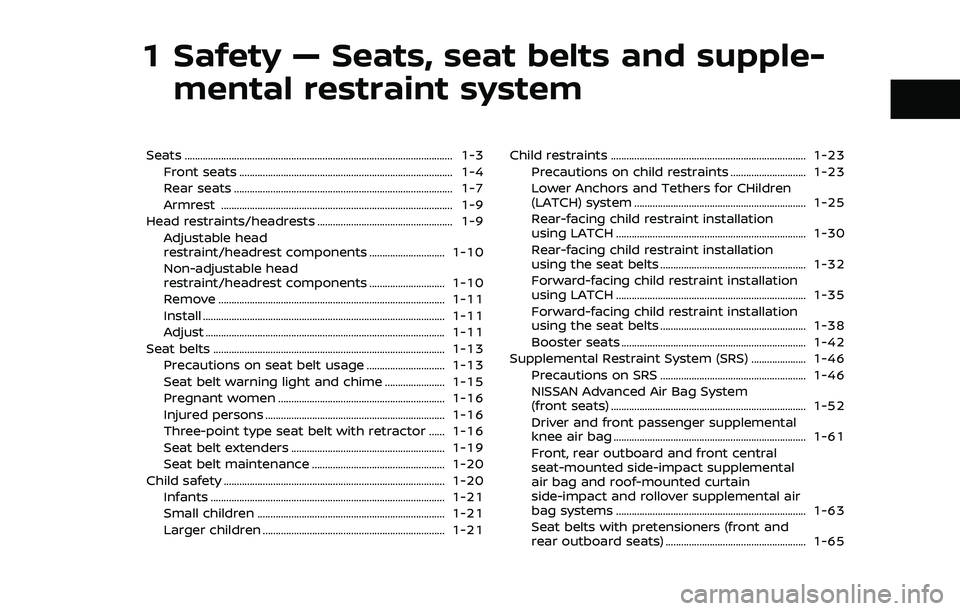
1 Safety — Seats, seat belts and supple-mental restraint system
Seats ........................................................................\
............................... 1-3
Front seats ........................................................................\
.......... 1-4
Rear seats ........................................................................\
............ 1-7
Armrest ........................................................................\
................. 1-9
Head restraints/headrests .................................................... 1-9 Adjustable head
restraint/headrest components ............................. 1-10
Non-adjustable head
restraint/headrest components ............................. 1-10
Remove ........................................................................\
............... 1-11
Install ........................................................................\
..................... 1-11
Adjust ........................................................................\
.................... 1-11
Seat belts ........................................................................\
................. 1-13
Precautions on seat belt usage .............................. 1-13
Seat belt warning light and chime ....................... 1-15
Pregnant women ................................................................ 1-16
Injured persons ..................................................................... 1-16
Three-point type seat belt with retractor ...... 1-16
Seat belt extenders ........................................................... 1-19
Seat belt maintenance ................................................... 1-20
Child safety ........................................................................\
............. 1-20 Infants ........................................................................\
.................. 1-21
Small children ........................................................................\
1-21
Larger children ...................................................................... 1-21 Child restraints ........................................................................\
... 1-23
Precautions on child restraints ............................. 1-23
Lower Anchors and Tethers for CHildren
(LATCH) system .................................................................. 1-25
Rear-facing child restraint installation
using LATCH ........................................................................\
. 1-30
Rear-facing child restraint installation
using the seat belts ........................................................ 1-32
Forward-facing child restraint installation
using LATCH ........................................................................\
. 1-35
Forward-facing child restraint installation
using the seat belts ........................................................ 1-38
Booster seats ....................................................................... 1-42
Supplemental Restraint System (SRS) ..................... 1-46 Precautions on SRS ........................................................ 1-46
NISSAN Advanced Air Bag System
(front seats) ........................................................................\
... 1-52
Driver and front passenger supplemental
knee air bag ........................................................................\
.. 1-61
Front, rear outboard and front central
seat-mounted side-impact supplemental
air bag and roof-mounted curtain
side-impact and rollover supplemental air
bag systems ........................................................................\
. 1-63
Seat belts with pretensioners (front and
rear outboard seats) ...................................................... 1-65
Page 27 of 556
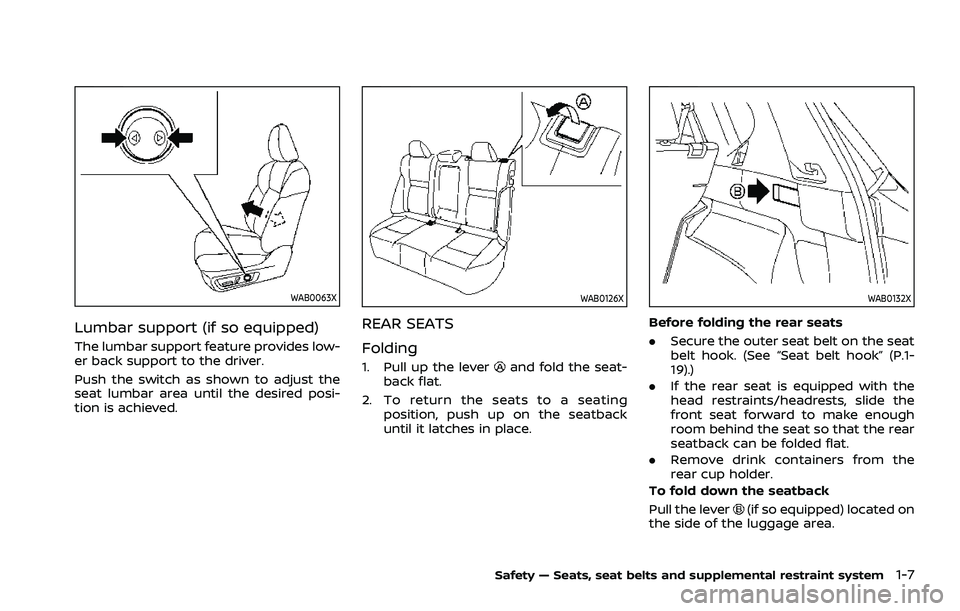
WAB0063X
Lumbar support (if so equipped)
The lumbar support feature provides low-
er back support to the driver.
Push the switch as shown to adjust the
seat lumbar area until the desired posi-
tion is achieved.
WAB0126X
REAR SEATS
Folding
1. Pull up the leverand fold the seat-
back flat.
2. To return the seats to a seating position, push up on the seatback
until it latches in place.
WAB0132X
Before folding the rear seats
.Secure the outer seat belt on the seat
belt hook. (See “Seat belt hook” (P.1-
19).)
. If the rear seat is equipped with the
head restraints/headrests, slide the
front seat forward to make enough
room behind the seat so that the rear
seatback can be folded flat.
. Remove drink containers from the
rear cup holder.
To fold down the seatback
Pull the lever
(if so equipped) located on
the side of the luggage area.
Safety — Seats, seat belts and supplemental restraint system1-7
Page 28 of 556
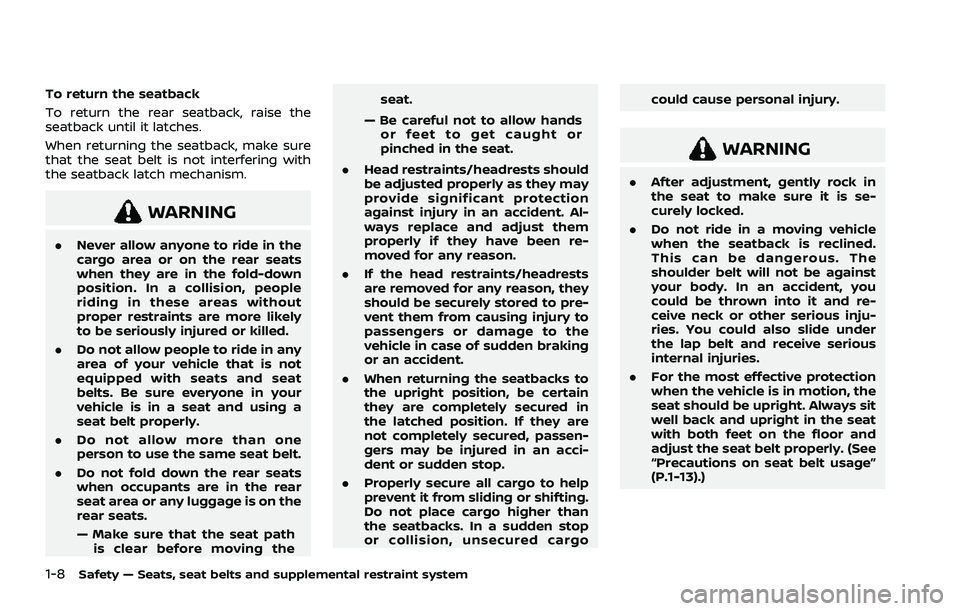
1-8Safety — Seats, seat belts and supplemental restraint system
To return the seatback
To return the rear seatback, raise the
seatback until it latches.
When returning the seatback, make sure
that the seat belt is not interfering with
the seatback latch mechanism.
WARNING
.Never allow anyone to ride in the
cargo area or on the rear seats
when they are in the fold-down
position. In a collision, people
riding in these areas without
proper restraints are more likely
to be seriously injured or killed.
. Do not allow people to ride in any
area of your vehicle that is not
equipped with seats and seat
belts. Be sure everyone in your
vehicle is in a seat and using a
seat belt properly.
. Do not allow more than one
person to use the same seat belt.
. Do not fold down the rear seats
when occupants are in the rear
seat area or any luggage is on the
rear seats.
— Make sure that the seat path
is clear before moving the seat.
— Be careful not to allow hands or feet to get caught or
pinched in the seat.
. Head restraints/headrests should
be adjusted properly as they may
provide significant protection
against injury in an accident. Al-
ways replace and adjust them
properly if they have been re-
moved for any reason.
. If the head restraints/headrests
are removed for any reason, they
should be securely stored to pre-
vent them from causing injury to
passengers or damage to the
vehicle in case of sudden braking
or an accident.
. When returning the seatbacks to
the upright position, be certain
they are completely secured in
the latched position. If they are
not completely secured, passen-
gers may be injured in an acci-
dent or sudden stop.
. Properly secure all cargo to help
prevent it from sliding or shifting.
Do not place cargo higher than
the seatbacks. In a sudden stop
or collision, unsecured cargo could cause personal injury.
WARNING
.
After adjustment, gently rock in
the seat to make sure it is se-
curely locked.
. Do not ride in a moving vehicle
when the seatback is reclined.
This can be dangerous. The
shoulder belt will not be against
your body. In an accident, you
could be thrown into it and re-
ceive neck or other serious inju-
ries. You could also slide under
the lap belt and receive serious
internal injuries.
. For the most effective protection
when the vehicle is in motion, the
seat should be upright. Always sit
well back and upright in the seat
with both feet on the floor and
adjust the seat belt properly. (See
“Precautions on seat belt usage”
(P.1-13).)
Page 29 of 556

JVR0327XRear seats
ARMREST
Pull the armrest down as shown.
WARNING
Head restraint/headrest supplement
the other vehicle safety systems.
They may provide additional protec-
tion against injury in certain rear end
collisions. Adjustable head re-
straints/headrests must be adjusted
properly, as specified in this section.
Check the adjustment after someone
else uses the seat. Do not attach
anything to the head restraint/head-
rest stalks or remove the head re-
straint/headrest. Do not use the seat
if the head restraint/headrest has
been removed. If the head restraint/
headrest was removed, reinstall and
properly adjust the head restraint/
headrest before an occupant uses
the seating position. Failure to follow
these instructions can reduce the
effectiveness of the head restraint/
headrest. This may increase the risk
of serious injury or death in a colli-
sion.
JVR0530X
The illustration shows the seating posi-
tions equipped with head restraint/head-
rest.
Indicates the seating position is
equipped with a head restraint.
Indicates the seating position is
equipped with a headrest.
+ Indicates the seating position is not
equipped with a head restraint or head-
rest.
. Your vehicle is equipped with a head
restraint/headrest that may be inte-
grated, adjustable or non-adjustable.
. Adjustable head restraints/headrests
have multiple notches along the stalk
to lock them in a desired adjustment
Safety — Seats, seat belts and supplemental restraint system1-9
HEAD RESTRAINTS/HEADRESTS
Page 30 of 556

1-10Safety — Seats, seat belts and supplemental restraint system
position.
. The non-adjustable head restraints/
headrests have a single locking notch
to secure them to the seat frame.
. Proper Adjustment:
— For the adjustable type, align the
head restraint/headrest so the
center of your ear is approximately
level with the center of the head
restraint/headrest.
— If your ear position is still higher than the recommended alignment,
place the head restraint/headrest
at the highest position.
. If the head restraint/headrest has
been removed, ensure that it is re-
installed and locked in place before
riding in that designated seating posi-
tion.
SSS0992
ADJUSTABLE HEAD RESTRAINT/
HEADREST COMPONENTS
1. Removable head restraint/headrest
2. Multiple notches
3. Lock knob
4. Stalks
JVR0203X
NON-ADJUSTABLE HEAD RE-
STRAINT/HEADREST COMPONENTS
1. Removable head restraint/headrest
2. Single notch
3. Lock knob
4. Stalks
Page 31 of 556

SSS1037
REMOVE
Use the following procedure to remove
the head restraint/headrest.
1. Pull the head restraint/headrest up tothe highest position.
2. Push and hold the lock knob.
3. Remove the head restraint/headrest from the seat.
4. Store the head restraint/headrest properly in a secure place so it is not
loose in the vehicle.
5. Reinstall and properly adjust the head restraint/headrest before an occu-
pant uses the seating position.
SSS1038
INSTALL
1. Align the head restraint/headreststalks with the holes in the seat. Make
sure that the head restraint/headrest
is facing the correct direction. The
stalk with the adjustment notch
must be installed in the hole with the
lock knob.
2. Push and hold the lock knob and push the head restraint/headrest down.
3. Properly adjust the head restraint/ headrest before an occupant uses
the seating position.
SSS0997
ADJUST
For adjustable head restraint/headrest
Adjust the head restraint/headrest so the
center is level with the center of your ears.
If your ear position is still higher than the
recommended alignment, place the head
restraint/headrest at the highest posi-
tion.
Safety — Seats, seat belts and supplemental restraint system1-11
Page 49 of 556

SSS0644LATCH rigid-mounted attachment
When installing a child restraint, carefully
read and follow the instructions in this
manual and those supplied with the child
restraint.
Top tether anchor
WARNING
Properly secure cargo and do not
allow it to contact the top tether
strap when it is attached to the top
tether anchor. Cargo that is not
properly secured or cargo that con-
tacts the top tether strap may da-
mage the top tether strap during acollision. If the cargo cover (if so
equipped) contacts the top tether
strap when it is attached to the top
tether anchor, remove the cargo
cover from the vehicle. If the cargo
cover is not removed, it may damage
the top tether strap during a colli-
sion. Your child could be seriously
injured or killed in a collision if the
child restraint top tether strap is
damaged.
WAB0110X
Top tether anchor point locations
WARNING
Child restraint anchorages are de-
signed to withstand only those loads
imposed by correctly fitted child
restraints. Under no circumstances
are they to be used to attach adult
seat belts, or other items or equip-
ment to the vehicle. Doing so could
damage the child restraint an-
chorages. The child restraint will not
be properly installed using the da-
maged anchorage, and a child could
be seriously injured or killed in a
Safety — Seats, seat belts and supplemental restraint system1-29
Page 51 of 556
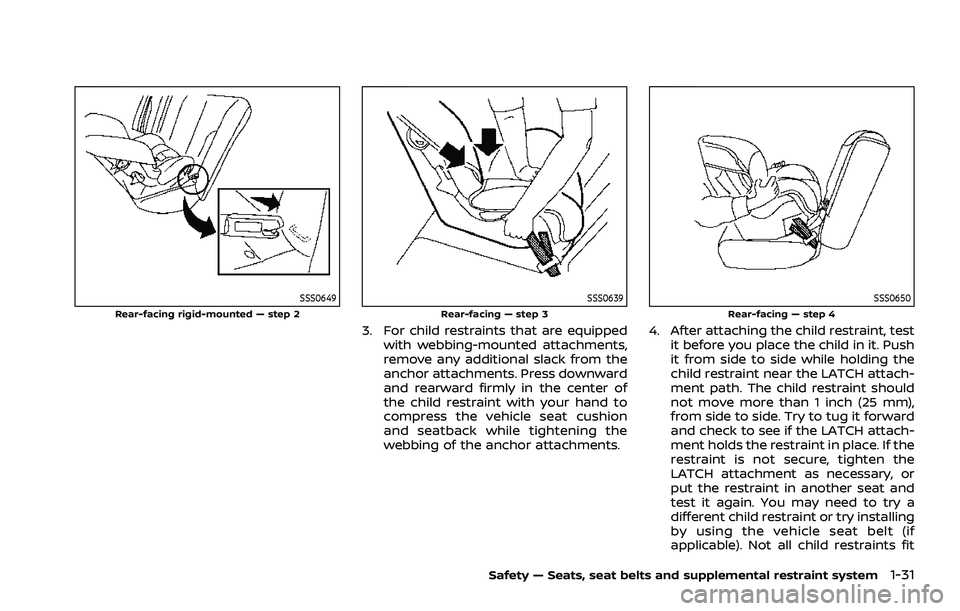
SSS0649Rear-facing rigid-mounted — step 2SSS0639Rear-facing — step 3
3. For child restraints that are equippedwith webbing-mounted attachments,
remove any additional slack from the
anchor attachments. Press downward
and rearward firmly in the center of
the child restraint with your hand to
compress the vehicle seat cushion
and seatback while tightening the
webbing of the anchor attachments.
SSS0650Rear-facing — step 4
4. After attaching the child restraint, testit before you place the child in it. Push
it from side to side while holding the
child restraint near the LATCH attach-
ment path. The child restraint should
not move more than 1 inch (25 mm),
from side to side. Try to tug it forward
and check to see if the LATCH attach-
ment holds the restraint in place. If the
restraint is not secure, tighten the
LATCH attachment as necessary, or
put the restraint in another seat and
test it again. You may need to try a
different child restraint or try installing
by using the vehicle seat belt (if
applicable). Not all child restraints fit
Safety — Seats, seat belts and supplemental restraint system1-31
Page 54 of 556
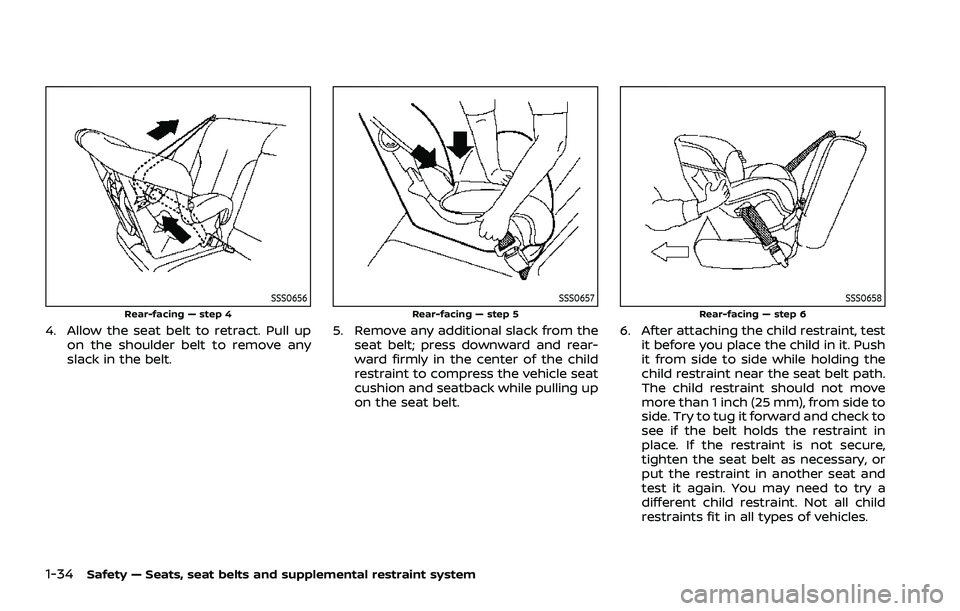
1-34Safety — Seats, seat belts and supplemental restraint system
SSS0656Rear-facing — step 4
4. Allow the seat belt to retract. Pull upon the shoulder belt to remove any
slack in the belt.
SSS0657Rear-facing — step 5
5. Remove any additional slack from theseat belt; press downward and rear-
ward firmly in the center of the child
restraint to compress the vehicle seat
cushion and seatback while pulling up
on the seat belt.
SSS0658Rear-facing — step 6
6. After attaching the child restraint, testit before you place the child in it. Push
it from side to side while holding the
child restraint near the seat belt path.
The child restraint should not move
more than 1 inch (25 mm), from side to
side. Try to tug it forward and check to
see if the belt holds the restraint in
place. If the restraint is not secure,
tighten the seat belt as necessary, or
put the restraint in another seat and
test it again. You may need to try a
different child restraint. Not all child
restraints fit in all types of vehicles.
Page 55 of 556

7. Check to make sure that the childrestraint is properly secured prior to
each use. If the seat belt is not locked,
repeat steps 1 through 6.
After the child restraint is removed and
the seat belt fully retracted, the ALR mode
(child restraint mode) is canceled.FORWARD-FACING CHILD RE-
STRAINT INSTALLATION USING
LATCH
For additional information, refer to all
Warnings and Cautions in the “Child
safety” and “Child restraints” sections
before installing a child restraint.
Do not use the lower anchors if the
combined weight of the child and the
child restraint exceeds 65 lbs (29.5 kg). If
the combined weight of the child and the
child restraint is greater than 65 lbs (29.5
kg), use the vehicle’s seat belt (not the
lower anchors) to install the child re-
straint. Be sure to follow the child re-
straint manufacturer’s instructions for
installation.
Follow these steps to install a forward-
facing child restraint using the LATCH
system:
1. Position the child restraint on the seat. Always follow the child restraint man-
ufacturer’s instructions.
SSS0645Forward-facing web-mounted — step 2
2. Secure the child restraint anchor at-
tachments to the LATCH lower an-
chors. Check to make sure the LATCH
attachment is properly attached to
the lower anchors.
If the child restraint is equipped with a
top tether strap, route the top tether
strap and secure the tether strap to
the tether anchor point. See “Installing
top tether strap” (P.1-37). Do not install
child restraints that require the use of
a top tether strap in seating positions
that do not have a top tether anchor.
Safety — Seats, seat belts and supplemental restraint system1-35